Annual Heating and Hot Water Load Reduction Effect of Air-Based Solar Heating System Using Thermal Simulation
Abstract
:1. Introduction
2. Simulation Conditions
3. Simulation Model of Solar Collector
4. Performance of the Air-Based Solar Heating System
4.1. Simulation Results for Typical House (Non-Solar Heat Collection)
4.2. Simulation Results for the Air-Based Solar Heating System
5. Conclusions
Author Contributions
Funding
Conflicts of Interest
Nomenclature
| Ac | Collector area [m2] |
| Afloor | Surface area of room floor [m2] |
| Ahs | Surface area of heat storage [m2] |
| Asd, Asu | Area of collector frontside and backside, respectively [m2] |
| asu | Absorption rate of solar collector [-] |
| cf | Specific heat of air static pressure [J kg−1 K−1] |
| cpa | Volume-specific heat of air [J m−3 K−1] |
| cpm | Specific heat of heating medium [J kg−1 K−1] |
| Fh | Mass flow rate of heating medium in handling box [kg s−1] |
| Gf | Mass flow rate of air [kg s−1] |
| I | Solar irradiation on inclined surface [W m−2] |
| Kc | Overall coefficient of heat transfer of collector [W m−2 K−1] |
| Kcu | Overall coefficient of heat transfer on the outdoor side [W m−2 K−1] |
| Kcd | Overall coefficient of heat transfer on the indoor side [W m−2 K−1] |
| kd | Ratio of the heat transmittance on the indoor side [-] |
| ku | Ratio of the heat transmittance on the outdoor side [-] |
| Qab | Heat absorption to heat storage [Wh] |
| Qc | Heat collection intensity [Wh] |
| Qf | Heat transmission [Wh] |
| Qht | Heat amount to heating [Wh] |
| Qhw | Heat amount to hot water supply [Wh] |
| Qin | Heat collection amount referenced to room temperature [Wh] |
| Qout | Heat collection amount referenced to outside temperature [Wh] |
| Qr | Heat supply to room [Wh] |
| Qra | Heat radiation from heat storage [Wh] |
| T(h) | Time period [h] |
| Qunder | Heat supply to underfloor space [W] |
| Qv | Ventilation load [W] |
| ra | Thermal resistance of hollow layer [m2 K W−1] |
| rb | Thermal resistance of surface material [m2 K W−1] |
| Rskyc | Longwave radiation to sky [W m−2] |
| Tcole | Sol-air temperature of collector [°C] |
| Tcoled | Sol-air temperature on the indoor side [°C] |
| Tcoleu | Sol-air temperature on the outside air side [°C] |
| Tduct | Outlet temperature of air in handling box [°C] |
| Tfin | Collector inlet temperature, outside temperature [°C] |
| Tfloor | Surface temperature of room floor [°C] |
| Tfout | Collector outlet temperature [°C] |
| Tfin | Collector inlet temperature [°C] |
| Thin | Inlet temperature of heating medium in handling box [°C] |
| Thout | Outlet temperature of heating medium in handling box [°C] |
| Ths | Surface temperature of thermal storage [°C] |
| To | Outside temperature [°C] |
| Tunder | Underfloor space temperature [°C] |
| Tx | Collector backside temperature [°C] |
| Vc | Volume flow rate of air in collection [m3 s−1] |
| Wsd, Wsu | Width of collector frontside and backside, respectively [m] |
| αc | Coefficient of heat transfer by convection [W m−2 K−1] |
| αo | Overall coefficient of heat transfer [W m−2 K−1] |
| αr | Coefficient of heat transfer by radiation [W m−2 K−1] |
| εc | Thermal efficiency of heat exchanger in collector [-] |
| τg | Solar transmittance of glazing [-] |
References
- Kannan, N.; Vakeesan, D. Solar energy for future world:—A review. Renew. Sustain. Energy Rev. 2016, 62, 1092–1105. [Google Scholar] [CrossRef]
- Bliss, R.W. The derivations of several plate efficiency factors useful in the design of flat—Plate solar heat collectors. Sol. Energy 1959, 3, 55–61. [Google Scholar] [CrossRef]
- Hill, J.E.; Streed, E.R. A method of testing for rating solar collectors based on thermal performance. Sol. Energy 1976, 18, 421–429. [Google Scholar] [CrossRef]
- Dorfling, C.; Hornung, C.H.; Hallmark, B.; Beaumont, R.J.J.; Fovargue, H.; Mackley, M.R. The experimental response and modelling of a solar heat collector fabricated from plastic microcapillary films. Sol. Energy Mater. Sol. Cells 2010, 94, 1207–1221. [Google Scholar] [CrossRef]
- Wei, L.; Yuan, D.; Tang, D.; Wu, B. A study on a flat-plate type of solar heat collector with an integrated heat pipe. Sol. Energy 2013, 97, 19–25. [Google Scholar] [CrossRef]
- Hussein, H.M.S.; Mohamad, M.A.; El-Asfouri, A.S. Optimization of a wickless heat pipe flat plate solar collector. Energy Convers. Manag. 1999, 40, 1949–1961. [Google Scholar] [CrossRef]
- Alvarez, A.; Cabeza, O.; Muñiz, M.C.; Varela, L.M. Experimental and numerical investigation of a flat-plate solar collector. Energy 2010, 35, 3707–3716. [Google Scholar] [CrossRef]
- Huang, B.J.; Lin, T.H.; Hung, W.C.; Sun, F.S. Performance evaluation of solar photovoltaic/thermal systems. Sol. Energy 2001, 70, 443–448. [Google Scholar] [CrossRef]
- He, W.; Chow, T.T.; Ji, J.; Lu, J.; Pei, G.; Chan, L.S. Hybrid photovoltaic and thermal solar-collector designed for natural circulation of water. Appl. Energy 2006, 83, 199–210. [Google Scholar] [CrossRef]
- Coventry, J.S. Performance of a concentrating photovoltaic/thermal solar collector. Sol. Energy 2005, 78, 211–222. [Google Scholar] [CrossRef]
- Ji, J.; Lu, J.P.; Chow, T.T.; He, W.; Pei, G. A sensitivity study of a hybrid photovoltaic/thermal water-heating system with natural circulation. Appl. Energy 2007, 84, 222–237. [Google Scholar] [CrossRef]
- Bergene, T.; Løvvik, O.M. Model calculations on a flat-plate solar heat collector with integrated solar cells. Sol. Energy 1995, 55, 453–462. [Google Scholar] [CrossRef]
- Zondag, H.A.; De Vries, D.W.; Van Helden, W.G.J.; Van Zolingen, R.J.C.; Van Steenhoven, A.A. The thermal and electrical yield of a PV-thermal collector. Sol. Energy 2002, 72, 113–128. [Google Scholar] [CrossRef] [Green Version]
- Ibrahim, A.; Othman, M.Y.; Ruslan, M.H.; Mat, S.; Sopian, K. Recent advances in flat plate photovoltaic/thermal (PV/T) solar collectors. Renew. Sustain. Energy Rev. 2011, 15, 352–365. [Google Scholar] [CrossRef]
- Chow, T.T. A review on photovoltaic/thermal hybrid solar technology. Appl. Energy 2010, 87, 365–379. [Google Scholar] [CrossRef]
- Zondag, H.A. Flat-plate PV-Thermal collectors and systems: A review. Renew. Sustain. Energy Rev. 2008, 12, 891–959. [Google Scholar] [CrossRef] [Green Version]
- Riffat, S.B.; Cuce, E. A review on hybrid photovoltaic/thermal collectors and systems. Int. J. Low-Carbon Technol. 2011, 6, 212–241. [Google Scholar] [CrossRef] [Green Version]
- Aste, N.; del Pero, C.; Leonforte, F. Water flat plate PV-thermal collectors: A review. Sol. Energy 2014, 102, 98–115. [Google Scholar] [CrossRef]
- Amori, K.E.; Taqi Al-Najjar, H.M. Analysis of thermal and electrical performance of a hybrid (PV/T) air based solar collector for Iraq. Appl. Energy 2012, 98, 384–395. [Google Scholar] [CrossRef]
- Choi, Y.; Takase, K.; Mae, M. System performance of a residential building using the air-based solar heating system. Sol. Energy 2018, 171, 47–63. [Google Scholar] [CrossRef]
- Sarhaddi, F.; Farahat, S.; Ajam, H.; Behzadmehr, A.; Mahdavi Adeli, M. An improved thermal and electrical model for a solar photovoltaic thermal (PV/T) air collector. Appl. Energy 2010, 87, 2328–2339. [Google Scholar] [CrossRef]
- Amori, K.E.; Abd-AlRaheem, M.A. Field study of various air based photovoltaic/thermal hybrid solar collectors. Renew. Energy 2014, 63, 402–414. [Google Scholar] [CrossRef]
- Othman, M.Y.H.; Sopian, K.; Yatim, B.; Daud, W.R.W. Development of advanced solar assisted drying systems. Renew. Energy 2006, 31, 703–709. [Google Scholar] [CrossRef]
- Zhang, X.; Zhao, X.; Smith, S.; Xu, J.; Yu, X. Review of R&D progress and practical application of the solar photovoltaic/thermal (PV/T) technologies. Renew. Sustain. Energy Rev. 2012, 16, 599–617. [Google Scholar] [CrossRef]
- Arkar, C.; Šuklje, T.; Vidrih, B.; Medved, S. Performance analysis of a solar air heating system with latent heat storage in a lightweight building. Appl. Therm. Eng. 2016, 95, 281–287. [Google Scholar] [CrossRef]
- Kumar, A.; Kim, M.H. Solar air-heating system with packed-bed energy-storage systems. Renew. Sustain. Energy Rev. 2017, 72, 215–227. [Google Scholar] [CrossRef]
- Zhao, D.; Ji, J.; Yu, H.; Wei, W.; Zheng, H. Numerical and experimental study of a combined solar Chinese kang and solar air heating system based on Qinghai demonstration building. Energy Build. 2017, 143, 61–70. [Google Scholar] [CrossRef]
- Wang, Z.Y.; Diao, Y.H.; Liang, L.; Zhao, Y.H.; Zhu, T.T.; Bai, F.W. Experimental study on an integrated collector storage solar air heater based on flat micro-heat pipe arrays. Energy Build. 2017, 152, 615–628. [Google Scholar] [CrossRef]
- Wang, Z.; Diao, Y.; Zhao, Y.; Wang, T.; Liang, L.; Chi, Y. Experimental investigation of an integrated collector–storage solar air heater based on the lap joint-type flat micro-heat pipe arrays. Energy 2018, 160, 924–939. [Google Scholar] [CrossRef]
- Hu, M.; Zhao, B.; Ao, X.; Su, Y.; Pei, G. Parametric analysis and annual performance evaluation of an air-based integrated solar heating and radiative cooling collector. Energy 2018, 165, 811–824. [Google Scholar] [CrossRef]
- Youngjin, C. Performance Improvements of the Air-Based Solar Heating System (Improvement Method of Thermal Performance). E3S Web Conf. 2018, 64, 02004. [Google Scholar] [CrossRef]
- Institute for Building Environment and Energy Conservation. Design Guidelines for Low Energy Housing with Validated Effectiveness; IBEC: Tokyo, Japan, 2010. [Google Scholar]
- Udagawa, M.; Satoh, M.; Roh, H.; Higuchi, Y.; Kusunoki, T. Simulation Models of Building Envelopes for Active Solar Energy Use. In Proceedings of the JSES/JWEA Joint Conference, Chino, Japan, 2009; pp. 107–110. [Google Scholar]
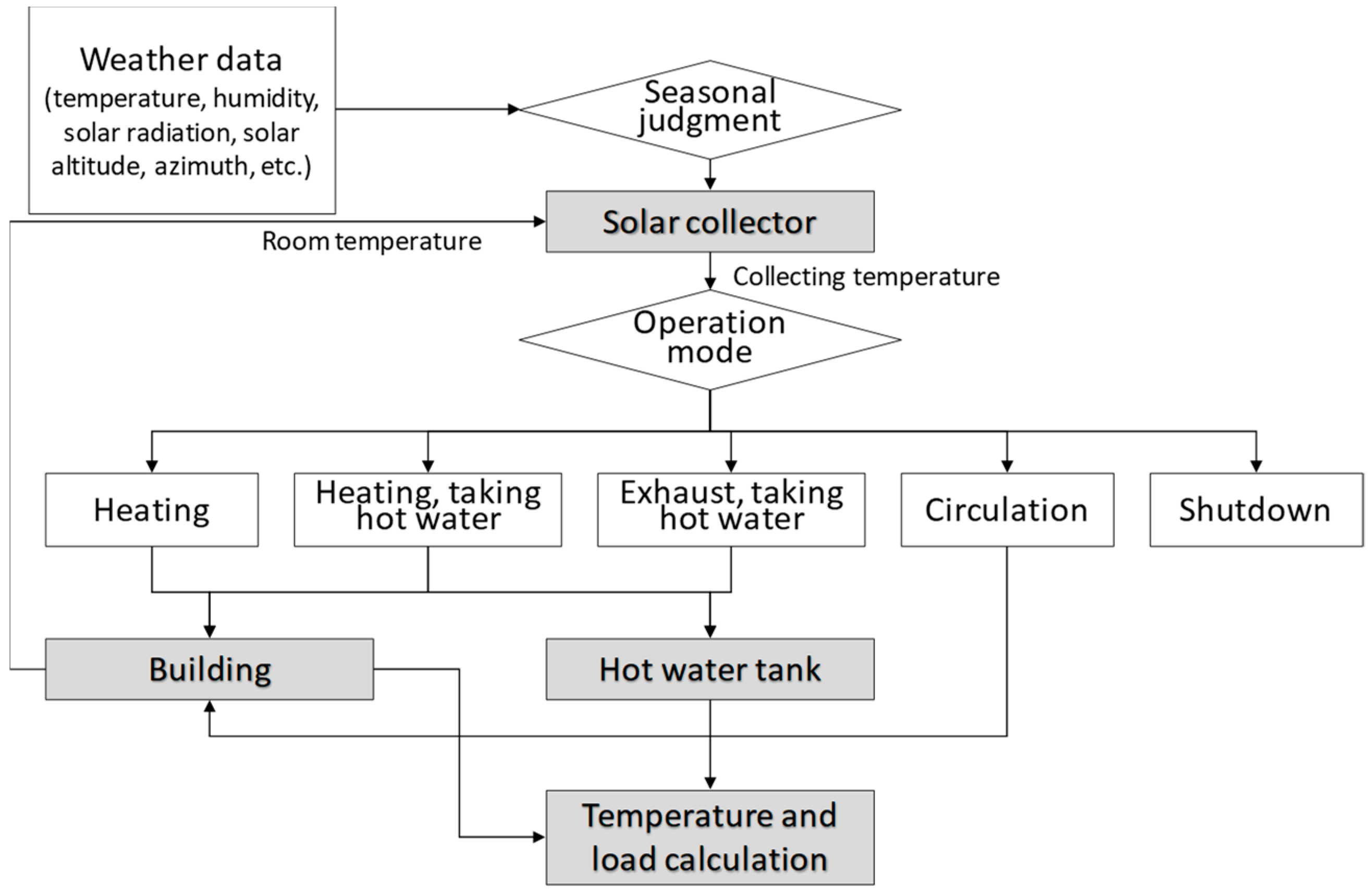
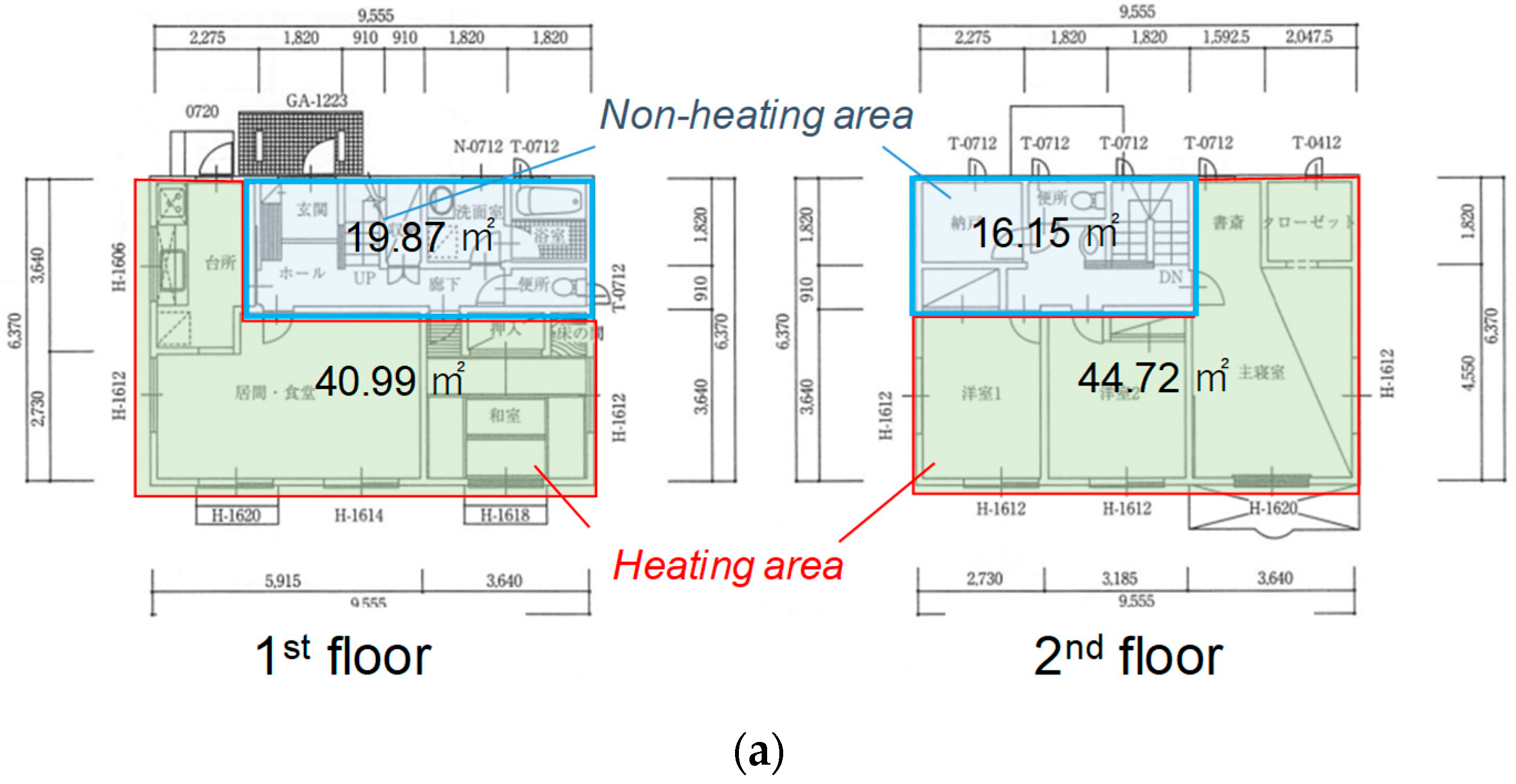

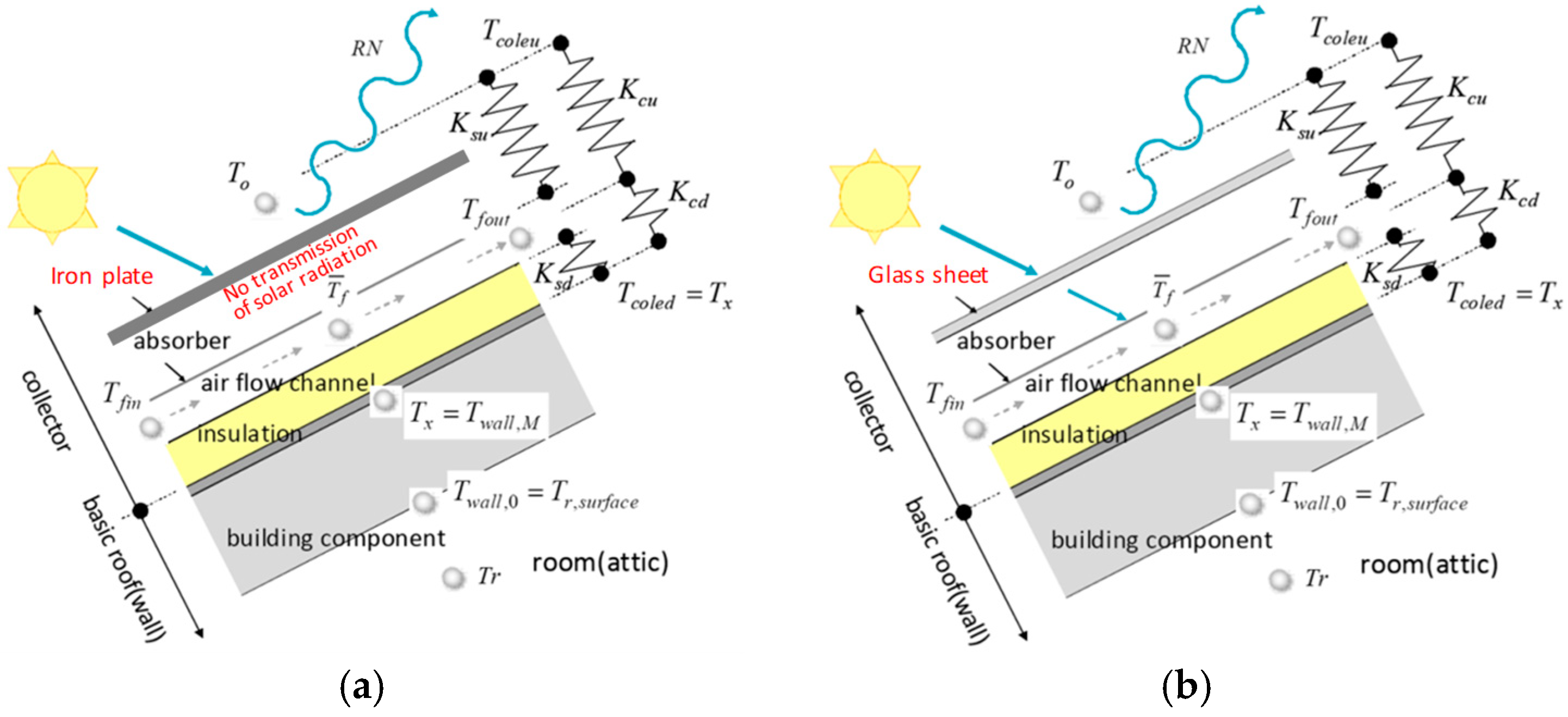

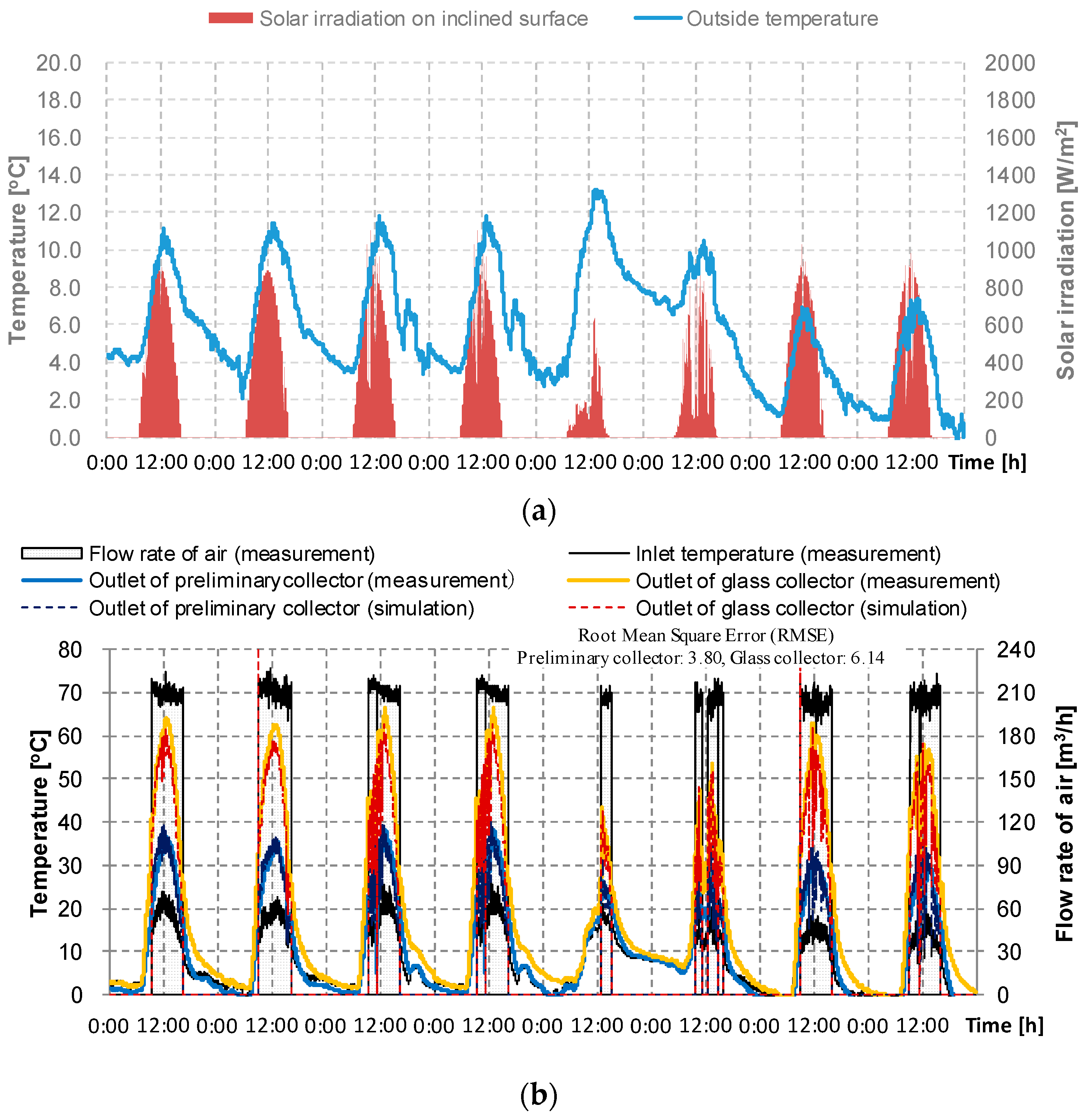
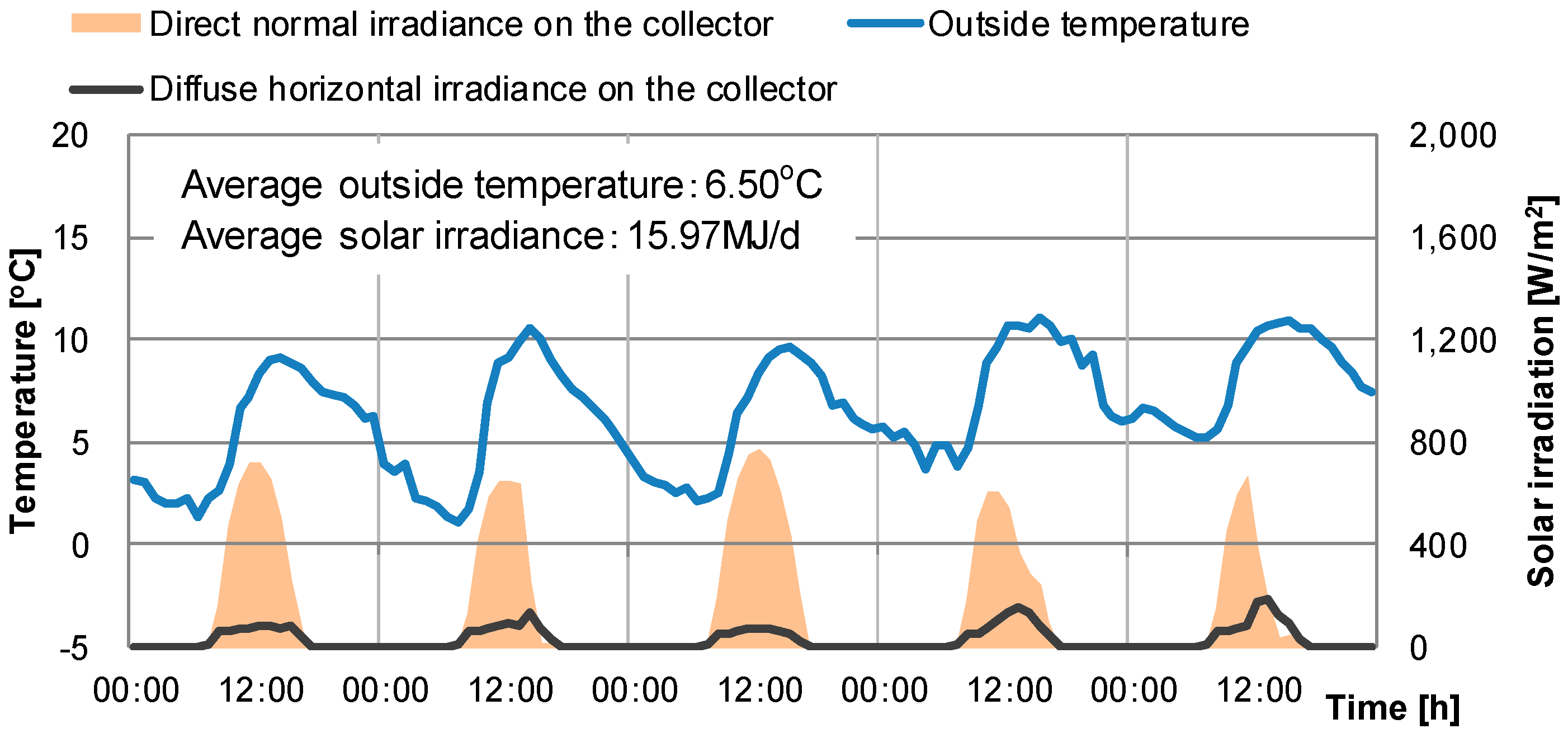
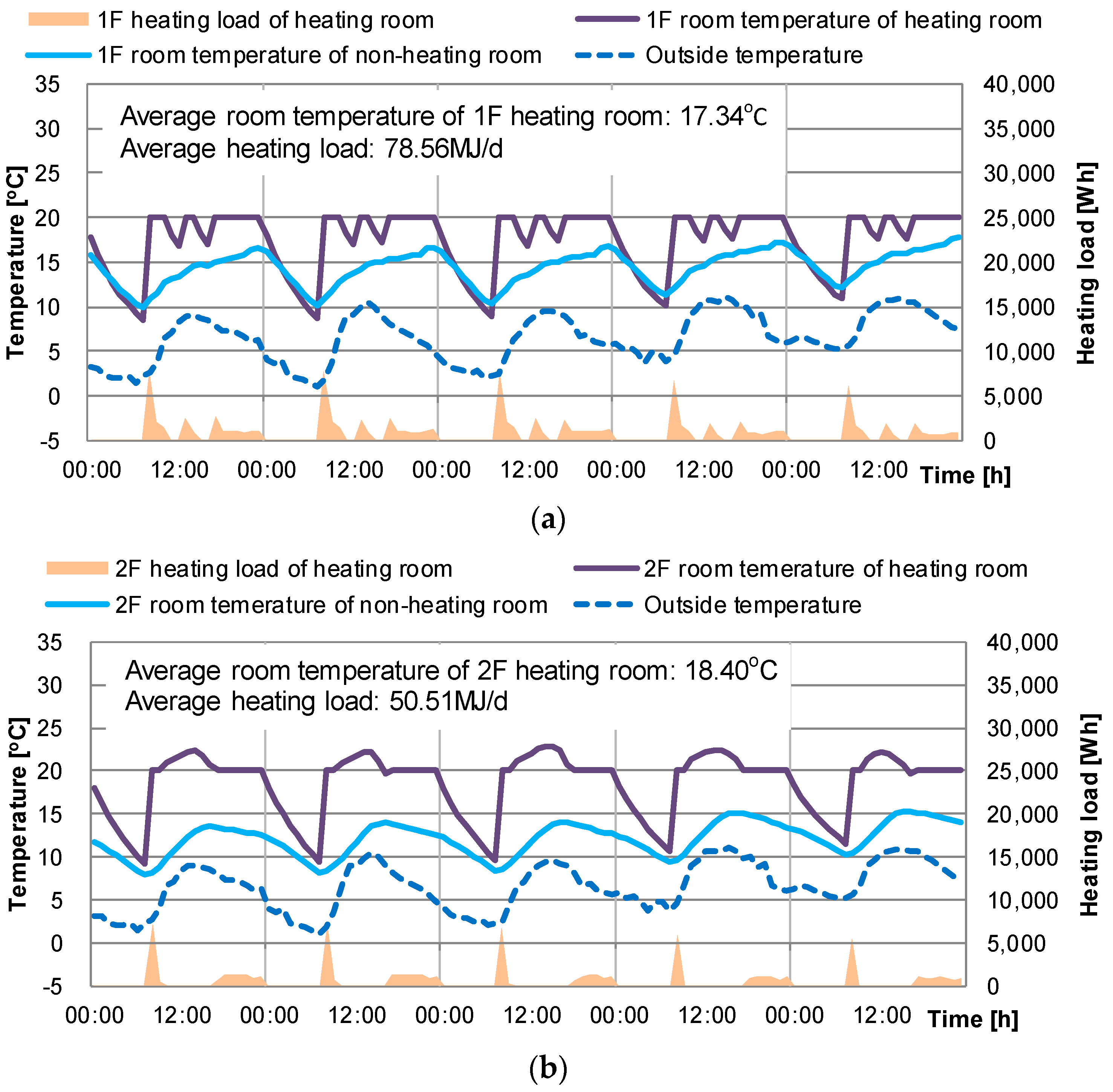
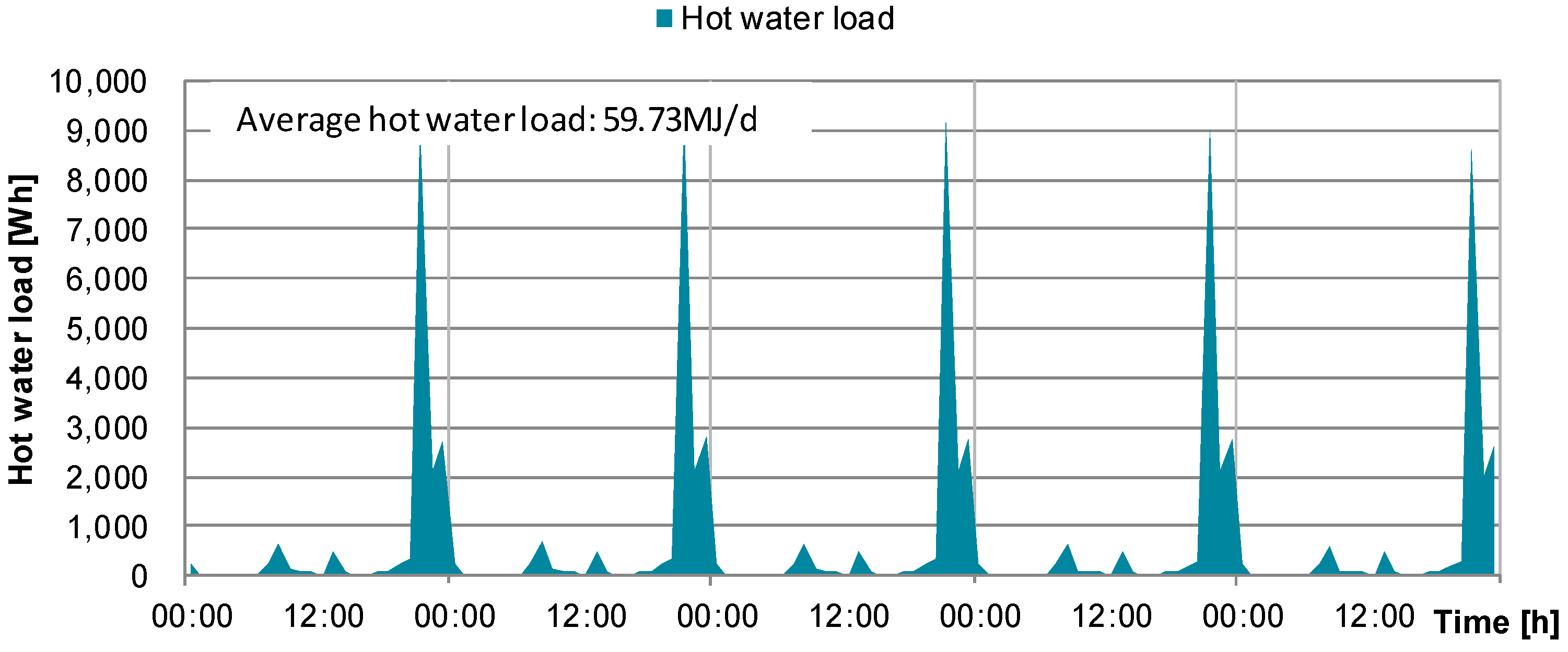
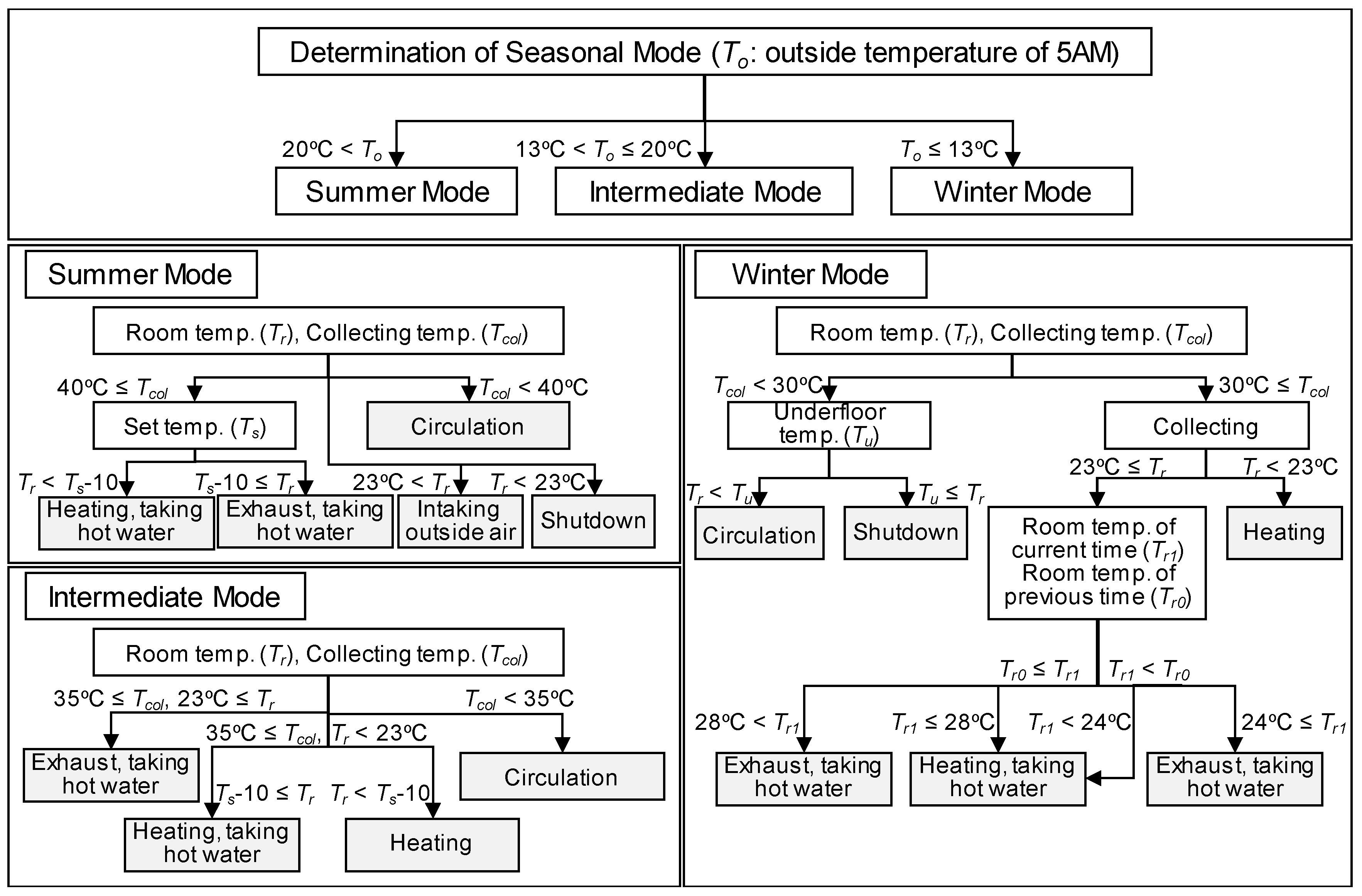
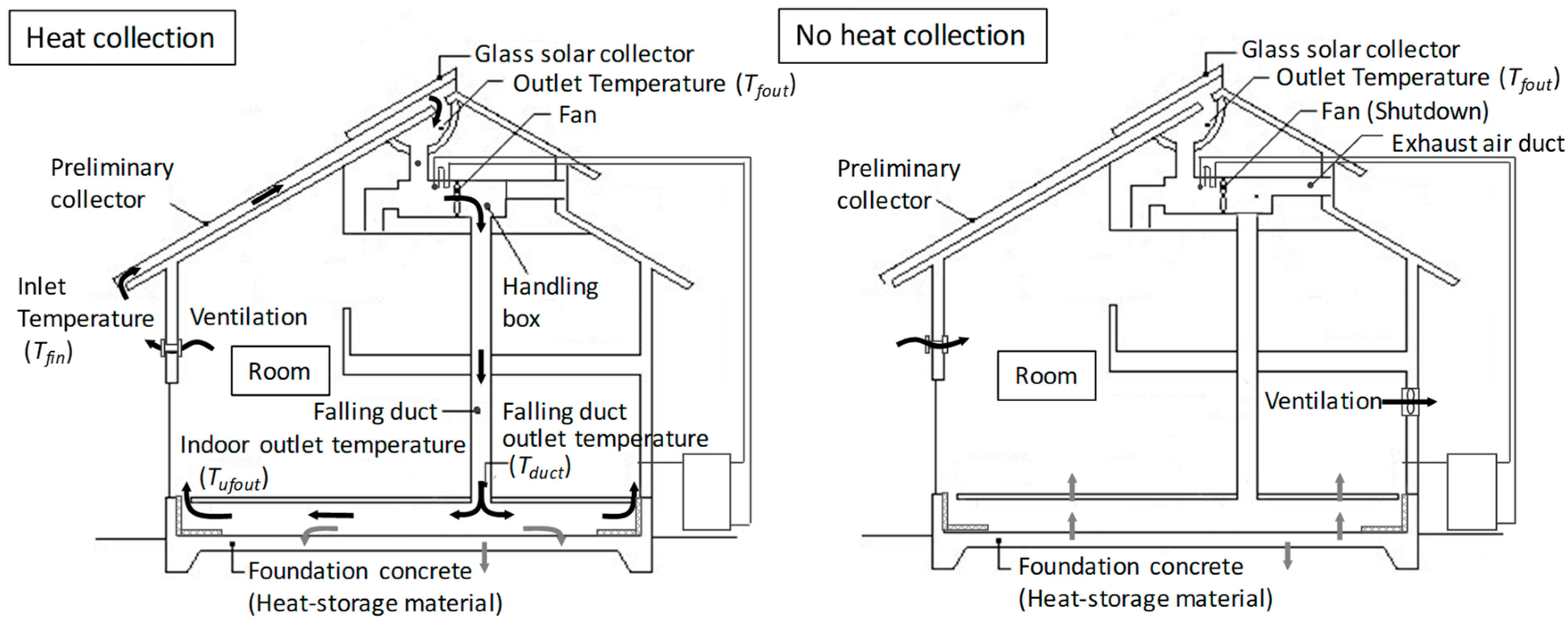


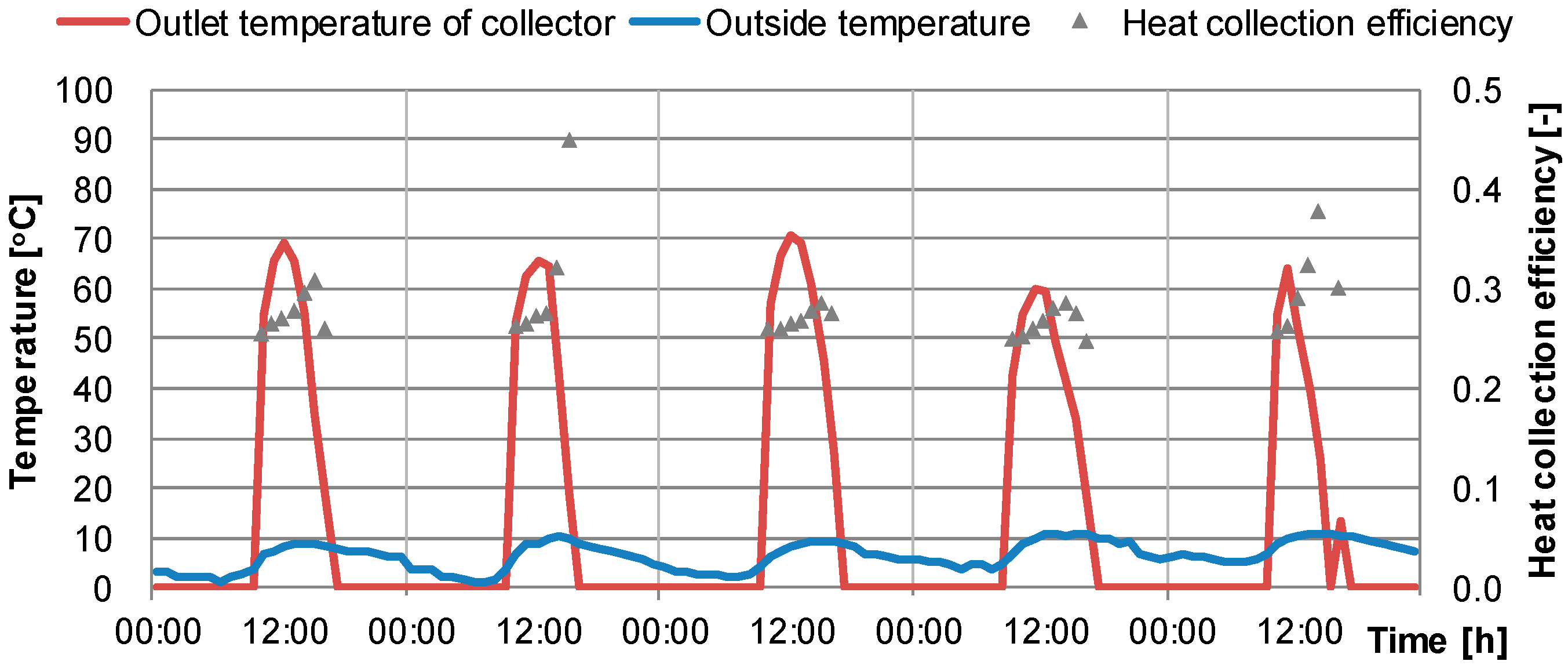
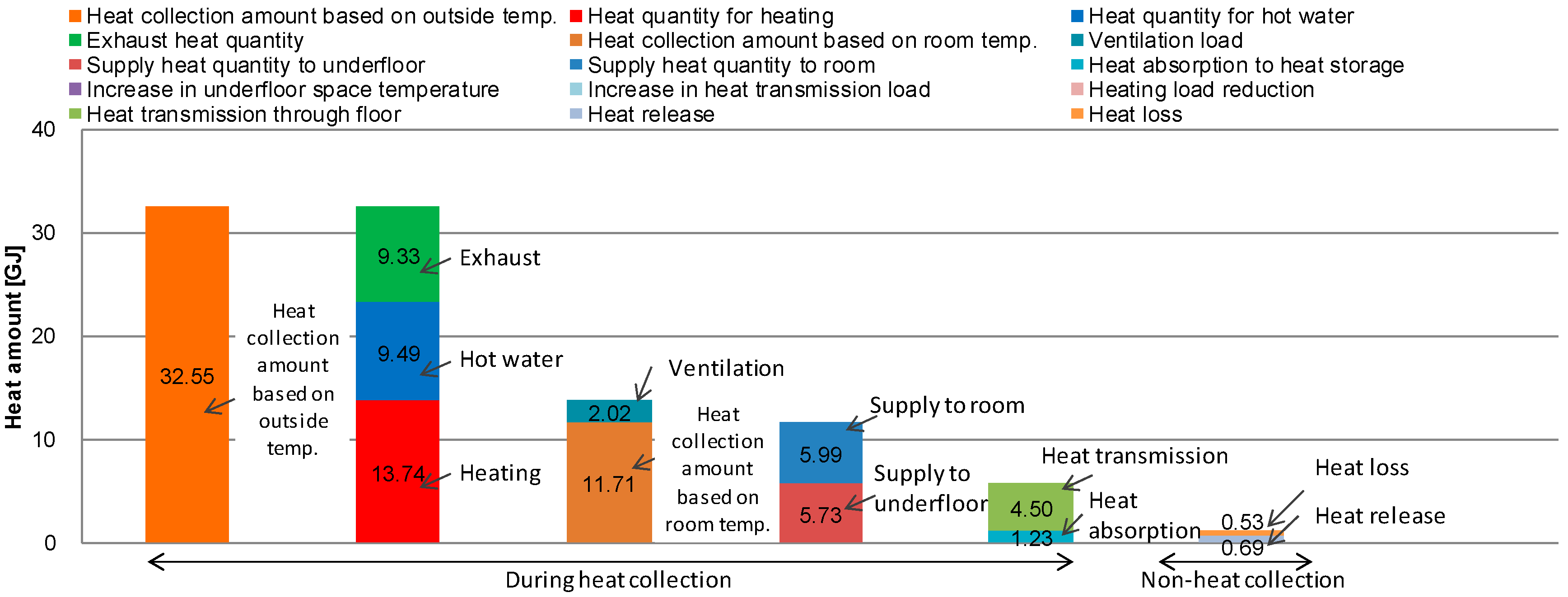

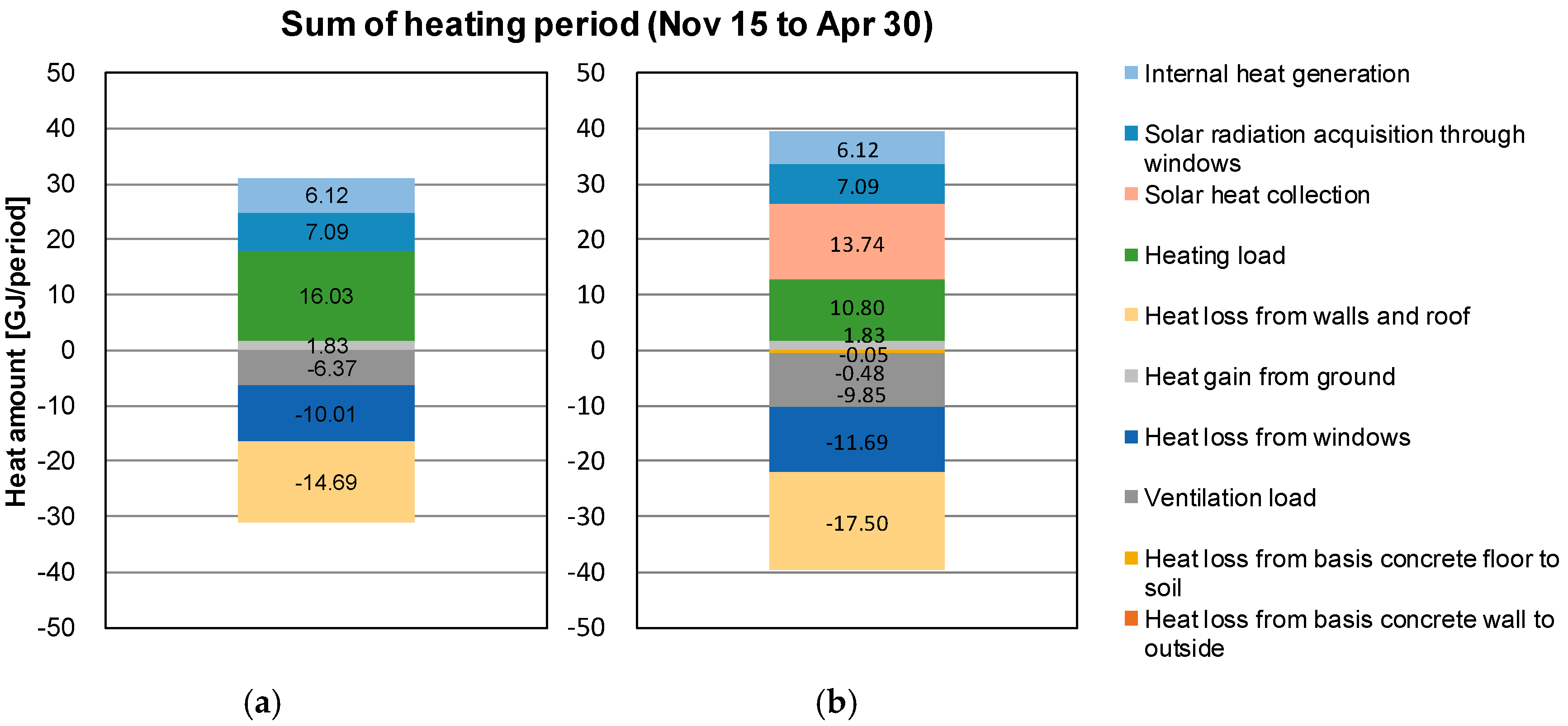
| Area | Total floor area: 121.73 m2 Heating area of 1st floor: 40.99 m2, Non-heating area of 1st floor: 19.87 m2 Heating area of 2nd floor: 44.72 m2, Non-heating area of 2nd floor: 16.15 m2 |
| Volume | 328.06 m3 (including underfloor space) |
| Insulation of each part | Ceiling: glasswool 18 kg m−3, t = 210 mm Wall: glasswool 16 kg m−3, t = 100 mm Roof: glasswool 32 kg m−3, t = 50 mm Basis concrete: extruded polystyrene foam, t = 50 mm |
| Window | Plain double-glazed glass (Uw: 4.65 W m−2 K−1) |
| Overall heat transfer coefficient (UA-value) | 0.83 W m−2 K−1 |
| Overall coefficient of heat transfer of hot water tank | 0.70 W m−2 K−1 (insulation: 50 mm, thermal conductivity: 0.036 W m−1 K−1) |
| Weather data | Expanded AMeDAS (Automated Meteorological Data Acquisition System) data standard (2000) Tokyo |
| Heating setpoint | 20 °C |
| Heating schedule | 07:00 to 10:00, 12:00 to 14:00, 16:00 to 23:00 |
| Inclination angle of collector | Latitude of Tokyo (35.4° N) |
| Calculation | Preliminary calculation: from January 1 to April 30, Target period: May 1 to April 30 of following year |
| Time step | 1 h |
| Usage of hot water | 450 L per day (40 °C for using hot water) |
| Internal heat gain | 13.26 kWh per day |
| Collector area Flow rate of air | Preliminary collector: 45 m2, glass collector: 15 m2 Volume flow rate of air: 780 m3 h−1 |
| Equipment [W] | Occupants [W] 60 W Per Person | Lighting [W] | ||||||||||
|---|---|---|---|---|---|---|---|---|---|---|---|---|
| 1F Heating | 1F Non-Heating | 2F Heating | 2F Non-Heating | 1F Heating | 1F Non-Heating | 2F Heating | 2F Non-Heating | 1F Heating | 1F Non-Heating | 2F Heating | 2F Non-Heating | |
| 1:00 | 66.9 | 41.5 | 18.0 | - | 0.0 | - | 240.0 | - | 0.0 | 0.0 | 0.0 | - |
| 2:00 | 66.9 | 41.5 | 18.0 | - | 0.0 | - | 240.0 | - | 0.0 | 0.0 | 0.0 | - |
| 3:00 | 66.9 | 41.5 | 18.0 | - | 0.0 | - | 240.0 | - | 0.0 | 0.0 | 0.0 | - |
| 4:00 | 66.9 | 41.5 | 18.0 | - | 0.0 | - | 240.0 | - | 0.0 | 0.0 | 0.0 | - |
| 5:00 | 66.9 | 41.5 | 18.0 | - | 0.0 | - | 240.0 | - | 0.0 | 0.0 | 0.0 | - |
| 6:00 | 66.9 | 41.5 | 18.0 | - | 0.0 | - | 240.0 | - | 0.0 | 0.0 | 0.0 | - |
| 7:00 | 84.3 | 41.5 | 18.0 | - | 60.0 | - | 180.0 | - | 22.6 | 101.6 | 0.0 | - |
| 8:00 | 269.1 | 95.1 | 18.0 | - | 120.0 | - | 0.0 | - | 97.5 | 171.8 | 0.0 | - |
| 9:00 | 270.6 | 57.0 | 18.0 | - | 60.0 | - | 0.0 | - | 52.5 | 101.3 | 0.0 | - |
| 10:00 | 167.8 | 41.5 | 293.1 | - | 60.0 | - | 0.0 | - | 115.0 | 174.3 | 105.0 | - |
| 11:00 | 117.4 | 41.5 | 18.0 | - | 0.0 | - | 0.0 | - | 17.5 | 76.0 | 0.0 | - |
| 12:00 | 66.9 | 41.5 | 18.0 | - | 0.0 | - | 0.0 | - | 0.0 | 0.0 | 0.0 | - |
| 13:00 | 185.2 | 41.5 | 18.0 | - | 60.0 | - | 0.0 | - | 67.5 | 34.9 | 0.0 | - |
| 14:00 | 218.7 | 41.5 | 18.0 | - | 60.0 | - | 0.0 | - | 52.5 | 47.5 | 0.0 | - |
| 15:00 | 66.9 | 41.5 | 18.0 | - | 0.0 | - | 0.0 | - | 0.0 | 0.0 | 0.0 | - |
| 16:00 | 66.9 | 41.5 | 18.0 | - | 0.0 | - | 0.0 | - | 0.0 | 0.0 | 0.0 | - |
| 17:00 | 167.8 | 41.5 | 18.0 | - | 60.0 | - | 0.0 | - | 35.1 | 98.3 | 0.0 | - |
| 18:00 | 218.7 | 41.5 | 18.0 | - | 120.0 | - | 0.0 | - | 70.0 | 64.3 | 0.0 | - |
| 19:00 | 303.9 | 41.5 | 18.0 | - | 120.0 | - | 60.0 | - | 70.0 | 104.6 | 35.0 | - |
| 20:00 | 269.1 | 41.5 | 18.0 | - | 180.0 | - | 0.0 | - | 80.0 | 111.0 | 35.0 | - |
| 21:00 | 269.1 | 41.5 | 63.0 | - | 180.0 | - | 60.0 | - | 120.0 | 148.2 | 52.5 | - |
| 22:00 | 269.1 | 148.8 | 445.5 | - | 120.0 | - | 60.0 | - | 70.0 | 267.4 | 122.5 | - |
| 23:00 | 242.9 | 41.5 | 118.3 | - | 60.0 | - | 120.0 | - | 70.0 | 273.3 | 140.0 | - |
| 0:00 | 242.9 | 95.1 | 49.8 | - | 60.0 | - | 180.0 | - | 35.1 | 79.8 | 87.5 | - |
| Time | Usage [L] | Time | Usage [L] |
|---|---|---|---|
| 06:30 | 3 | 20:15 | 15 |
| 06:35 | 3 | 20:20 | 15 |
| 07:20 | 10 | 20:25 | 15 |
| 07:25 | 3 | 20:30 | 15 |
| 07:30 | 3 | 20:35 | 15 |
| 08:25 | 3 | 20:45 | 150 |
| 09:30 | 3 | 21:15 | 20 |
| 10:15 | 3 | 21:20 | 3 |
| 12:45 | 5 | 21:25 | 25 |
| 12:50 | 10 | 21:30 | 25 |
| 13:45 | 3 | 21:45 | 3 |
| 16:00 | 3 | 22:00 | 10 |
| 17:15 | 3 | 22:05 | 10 |
| 18:00 | 3 | 22:15 | 3 |
| 18:15 | 3 | 22:30 | 25 |
| 19:15 | 3 | 22:35 | 25 |
| 19:20 | 3 | 23:00 | 3 |
| 19:25 | 3 | 23:05 | 3 |
| Ksu | Ksd | Kc | Tcoleu | Tcoled | SG | Tcole | |
|---|---|---|---|---|---|---|---|
| Glass collector | 1/(ra + 1/αo) | 1/rb | Kcu + Kcd | SG/Ksu − Rskyc/αo + To | Tx | (τg asu I)e | ku = Kcu/Kc |
| Preliminary collector | αo | (asu I) e | kd = Kcd/Kc |
| Item | Count | Sensor | Accuracy | |
|---|---|---|---|---|
| Weather observation | Outside temperature, relative humidity (RH) | Each 1 | Thermometer, hygrometer (−40–60 °C, 0–100% RH) | ±1.0% |
| Amount of solar radiation (horizontal) | 1 | Pyrheliometer (ISO9060 Second Class) | ±0.5% | |
| Amount of solar radiation (inclined) | 1 | Pyrheliometer (ISO9060 Second Class) | ±0.5% | |
| Wind direction, velocity | 1 | Anemometer (0–40 m/s, 0–355°) | ±1.0% | |
| Longwave radiation | 1 | Long wavelength radiometer (sensitivity 42.2 mV kW−1m−2) | ±0.5% | |
| SAT (Sol-air temperature) (horizontal, inclined) | Each 1 | Thermocouple | ±1.0 °C | |
| Collector | Inlet and outlet temperature | 6 | Thermocouple | ±1.0 °C |
| PV panel backside temperature | 8 | Thermocouple | ±1.0 °C | |
| Air temperature of aeration layer | 8 | Thermocouple | ±1.0 °C | |
| Duct temp. of ridge of a roof | 4 | Thermocouple | ±1.0 °C | |
| Handling box temperature | 4 | Thermocouple | ±1.0 °C | |
| Flow rate of air in the duct | 1 | Ultrasonic flow meter | ±1.0% | |
| Flow rate of air in solar collection and return duct | Each 1 | Pitot tube system | ±1.0% | |
| Duct temperature | 5 | Thermocouple | ±1.0 °C |
| Solar Irradiation on Inclined Surface [GJ] | Solar System Efficiency [%] | 1F Heating Load [GJ] | 2F Heating Load [GJ] | Hot Water Load [GJ] | Reduction of Heating Load [GJ] | Reduction of Hot Water Load [GJ] | Reduction Rate of Load [%] | |
|---|---|---|---|---|---|---|---|---|
| Typical house (no solar collection) | - | - | 9.72 | 6.92 | 15.87 | - | - | - |
| Air-based solar heating system | 292.9 | 24.5 | 5.67 | 5.58 | 5.55 | 5.39 | 10.32 | 48.3% |
© 2019 by the authors. Licensee MDPI, Basel, Switzerland. This article is an open access article distributed under the terms and conditions of the Creative Commons Attribution (CC BY) license (http://creativecommons.org/licenses/by/4.0/).
Share and Cite
Choi, Y.; Mae, M.; Roh, H.; Cho, W. Annual Heating and Hot Water Load Reduction Effect of Air-Based Solar Heating System Using Thermal Simulation. Energies 2019, 12, 1054. https://doi.org/10.3390/en12061054
Choi Y, Mae M, Roh H, Cho W. Annual Heating and Hot Water Load Reduction Effect of Air-Based Solar Heating System Using Thermal Simulation. Energies. 2019; 12(6):1054. https://doi.org/10.3390/en12061054
Chicago/Turabian StyleChoi, Youngjin, Masayuki Mae, Hyunwoo Roh, and Wanghee Cho. 2019. "Annual Heating and Hot Water Load Reduction Effect of Air-Based Solar Heating System Using Thermal Simulation" Energies 12, no. 6: 1054. https://doi.org/10.3390/en12061054




